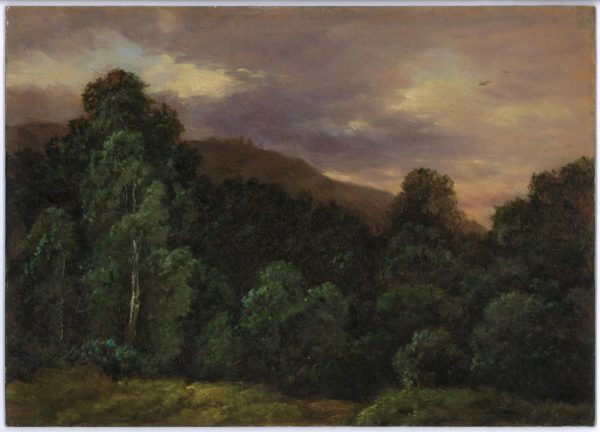The Edge of a Forest at Sunset, c. 1835-1840
Oil on canvas, H. 0.2 m; W. 0.28 m
Ink inscription on the verso: (…) / (…) / C. G. Carus / Rietschel / Ober (..) / Dresden. (…) 2.6.45.
Provenance: Ernst Friedrich Rietschel (1804-1861), Dresden
Private collection
Elisabeth Bülck, C. G. Carus, sein Leben und sein Werk im Verhältnis zu C. D. Friedrich und dessen Schülern betrachtet, unpublished Phd theses, Greifswald, 1943.
Marianne Prause, Carl Gustav Carus. Leben und Werk, Berlin, 1968, p. 173, no. 412.
At the edge of a forest, the final rays of a setting sun illuminate the foreground’s grass and expanse of trees, pushing a mid-ground screen of foliage into shadow. The sky sets this twilight scene in motion, as birds chase darkening clouds, and clear patches of blue occasionally pierce the billowing forms of white, purple and pink. This oil study, documented by Prause though not dated (no. 412), shares the relatively loose brushwork and attention to atmospheric effects of Carus’s oil studies from the mid-1830s and after. This painting reveals Carus’s growing interest in naturalist aesthetics, party guided by the examples of Johann Wolfgang von Goethe (1749-1832), with whom he frequently corresponded; Alexander von Humboldt (1769-1859); and the oil sketches of the Norwegian landscape painter, Johan Christian Dahl (1788-1857). By contrast, Carus’s earlier paintings (with their quasi-mystical motifs and tight execution) are deeply indebted to the example of his friend (since around 1816) and first mentor, Caspar David Friedrich.
A highly successful physician by profession, Carus is principally known for his landscape paintings and writings on psychological and aesthetic topics, including his Neun Briefe über Landschaftsmalerei (Nine Letters on Landscape Painting, completed in 1824, published in 1831). As a painter he was largely self-taught. In both the breadth and content of his projects – ranging from studies of animal anatomy, plant morphology and geology, to prescient musings on the human unconscious – he emerges as a great representative of the age of Goethe. As is evident in the Briefe in particular, it was Carus’s overarching ambition to unite the symbolic aspirations of German Romanticism with the empirical commitments and methods of science. Carus invented the term ‘Erdlebenbild’ (‘earth-life painting’) in the Briefe to describe a landscape practice based on scientific knowledge of the underlying structures of natural formations, such as mountains, and the observation of changing phenomena, such as light.
A passage from the second enclosure of Carus’s third Letter includes a description of the sky as the true image of infinity, and is suggestive of the metaphorical power that Carus ascribed to paintings like this one.
When our view of this infinity the sky is narrowed down, constrained, and obscured by clouds or by tall accumulations of other objects, the mind is proportionately constrained and oppressed; but let the veil of cloud break into silvery cloudlets, or disperse in the steady glow of the rising moon or of the sun, and our inner gloom is dispelled; we are uplifted by the thought that the infinite has prevailed over the finite (Cited in the introduction to Nine Letters on Landscape Painting, translated by David Britt, Los Angeles, 2002, p. 36).
Ernst Friedrich Rietschel (1804-1861), a successful sculptor who specialized in monuments of distinguished German historical figures and contemporaries. He owned many other paintings by Carus.

